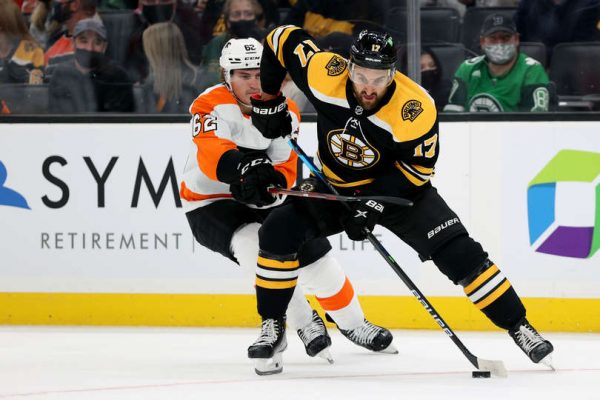
By: Ryan Duffy | Follow me on Twitter: @Rduffy26
With the home opener for the Bruins right around the corner on Saturday, October 16th, Bruce Cassidy and the coaching staff have seemed to finalize the top-nine forward roster. Of course, the top line will remain the same, and Charlie Coyle will be the second-line center with David Krejci gone. The way the third line with Jake Debrusk, Erik Haula, and Nick Foligno has looked in the preseason has been a pleasant surprise for Bruins fans.
All three players seemed to mesh well with one another and at least registered a point in the preseason. With the third line’s promising preseason, their regular-season success will determine if this Bruins team is a contender. Let’s start by looking at the most recent additions to the third line of Haula and Foligno and what they can bring to the lineup.
Haula is a creative playmaker who adds a ton of speed to the Bruin’s middle-six forwards. He’s a versatile forward that can play either center or wing and play in all situations on special teams. One knock on Haula’s game is that he’s been offensively inconsistent throughout his career year to year. Haula had his best offensive year during the 2017-18 inaugural season of the Vegas Golden Knights. Haula recorded 29 goals and 26 assists (55 points) in 76 games that season.
After that season, Haula has been a bit of a suitcase as he’s played for four different teams since the 2018-19 season. He collected 23 goals and 29 assists (52 points) in 114 games split between Vegas, Carolina, Florida, and Nashville. While the recent inconsistency is a concern, it’s tough for a player to develop chemistry with teammates when traded multiple times in three years. Based on the way he played in the preseason, and if he sticks on the third line with Boston, there is hope that he can return to a 50-point player.
On the other hand, Foligno is a veteran player with a more physical and power-forward style game. Since the 2016-17 season, Foligno has recorded 859 hits which rank 12th in all forwards. He’s another versatile forward that can be slotted as a center or wing and play in all situations. The former captain of the Columbus Blue Jackets is a well-renowned leader throughout the National Hockey League as he’s won both the King Clancy and Mark Messier leadership awards. He will fit well in the Bruins locker room and provide a solid presence to the leadership group.
Although he doesn’t necessarily put up big offensive numbers, he’s known for his strong two-way play. Over the past four seasons, he’s recorded 193 blocked shots (fifth in all left wings) and scored 49 goals and 70 assists (119 points) in 261 games. Last season, he was traded to the Toronto Maple Leafs, where he recorded four assists in seven games. Foligno missed 14 games last season due to quarantine regulations and struggled with a lower-body injury he sustained with Toronto. Foligno hasn’t played an entire regular season since his days in Ottawa in 2011-12. If Foligno can stay healthy through this season, he will be a valuable piece for this team, especially in the postseason.
To finalize the third line, Jake DeBrusk is looking to get back on track to where he was just a couple of seasons ago. As Bruins fans know, DeBrusk struggled to find his game in the 2020-21 season. He found himself at times serving a fourth-line role or even a healthy scratch. Ultimately, the pandemic has impacted every player in the NHL, but some players are affected by it differently. DeBrusk was one of the players the pandemic hit hard, and it affected his confidence on the ice.
Based on how DeBrusk played in the preseason, he seems rejuvenated and enjoys playing with his new linemates. DeBrusk notched two goals in the preseason and made plays that we didn’t see enough of last season. What made DeBrusk so effective before last season was that he wasn’t afraid to drive to the net or use his speed to the outside to beat defenders. Hopefully, with more communication between Cassidy and DeBrusk and playing with new linemates, he’ll be able to gain more confidence in himself this season.
The Bruins have heavily relied on their first line in previous seasons to carry the team and score timely goals. For the Bruins to be considered a contender for the Stanley Cup, the third line must be a consistent threat against Boston’s opponents and help relieve the burden off the top line. Consistency is a vital part of every contending team’s third line. Look at Tampa Bay’s former third line during their cup runs, for example.
Goodrow, Gourde, and Coleman didn’t always show up on the score sheet, but they were responsible defensively and forechecked hard in the offensive zone. Whenever Tampa Bay’s top lines weren’t getting it done, they would often rely on their third line to give them a boost by creating havoc on the forecheck or scoring a clutch goal. The Bruin’s third line has the pieces to do something like Tampa’s cup-winning third line, but they have to buy into their role as the checking line and be responsible on both ends of the ice.


Leave a Reply